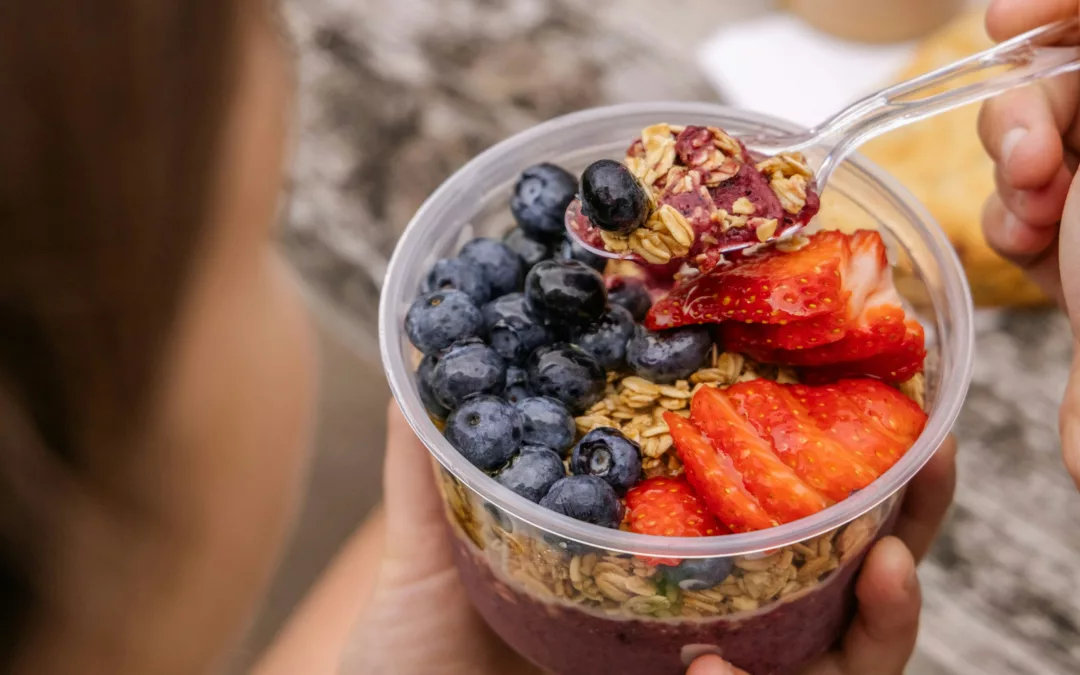Written by Kimberley Gittens, RD on behalf of Rachel McBryan, RD
I’m sure many of you have heard at one point or another, that you should eat more fibre. But what is fibre? What are the benefits of fibre? And why should we be eating more of it?
Fibre is a type of carbohydrate that is resistant to digestion and helps to promote gut health. Although fibre is technically a carbohydrate, you don’t actually get much energy (calories) from it because your body of how long it takes for your body to break it down and absorb it.
Fibre can be found in a wide variety of plant-based foods, from grain and beans to fruits and legumes.
Types of Fibre
Fibres are generally classified as soluble and insoluble. However, some fibres can fall into both groups.
Soluble Fibres
As their name suggests, soluble fibres are soluble in water. In our digestive tract, these fibres dissolve to form a gel-like substance that can slow the breakdown and absorption of food. Slowing down digestion can have health benefits including:
-
- Improved blood sugar control.
- By slowing down the digestion and absorption of carbohydrates, soluble fibre helps to prevent the spike in blood sugars after a meal and allows a slower, more gentle rise in blood sugars.
- Lower blood cholesterol.
- Soluble fibres can bind cholesterol in our digestive tract, which can limit the amount that is absorbed by our bodies and help reduce our total blood cholesterol levels.
- Improved blood sugar control.
Insoluble Fibres
These fibres are not soluble in water. They increase our stool bulk and encourage the movement of food through our digestive tract. By adding bulk to stool, insoluble fibres can help prevent constipation and may be particularly beneficial to people who struggle with irregular bowel movements.
To find out more about the different types of fibre, check out this fibre factsheet.
Health Benefits of Fibre
Both insoluble and soluble fibre are important parts of a healthy diet, and play a role in supporting your health. Some of the top health benefits of fibre include:
Promotes regular bowel movements
Together, soluble and insoluble fibre increases the weight and size of our stool and encourages movement through our digestive tract. Ultimately promoting regular bowel movements.
Reduces the risk of, and can help manage, chronic diseases
In addition to helping manage the rise in blood sugars after meals and our cholesterol levels, high-fibre diets also reduce the risk of diverticular disease and colorectal cancer. You can learn more about the role of fibre in the prevention of chronic diseases from the American Society of Colon & Rectal Surgeons’ website.
Healthy gut bacteria
There are thousands of good bacteria living in our gut. These bacteria support our health by producing vitamins and short-chain fatty acids, and even supporting our immune system.
These bacteria ferment fibre as their source of energy. Which makes it important to get enough fibre in your diet to support these healthy bacteria, and their functions.
Healthy weight management
High-fibre can help us feel full sooner, and stay full for longer than low-fibre alternatives. This means we are less likely to be snacking all day, or craving high-calorie foods. Additionally, high-fibre foods tend to have fewer calories than low-fibre foods.
Sources of Fibre
Although most fruits & vegetables contain both types of fibre, they usually have larger amounts of one type than the other. Many fibre-rich foods are also contain large amounts of FODMAPs, however there are some IBS-friendly sources of fibre.
Soluble Fibre
Soluble fibre can be found in many foods. Some of the top sources of soluble fibre include,
-
- Apples
- Citrus fruits
- Flaxseed
- Barley
- Oats
- Beans
- Peas
- Tofu and tempeh
- Passion fruit
- Psyllium husk

Insoluble Fibre
Including insoluble fibre in your diet is just as important as soluble fibre. Some of rich sources of insoluble fibre include:
-
- Whole wheat flour
- Wheat bran
- Potatoes
- Cauliflower
- Green beans
- Nuts
- Coconut
- Okra
- Spinach
- Turnips
- Berries (including blackberries, blueberries, strawberries)

How Much Do I Need?
According to Health Canada, women require 25 grams of total fibre each day, while men require 38 grams. However, Health Canada also reports that most Canadian’s only consume about half of their required fibre intakes. Currently, there is no recommendation on the amount of soluble and insoluble fibre you should consume each day.
You can read more on fibre recommendations & how you ensure you’re consuming enough fibre on Health Canada’s % Daily Value page.
Not sure if you're getting enough fibre?
Ready to boost your health with personalized nutrition recommendations? Book a FREE discovery call with a Registered Dietitian to get started!
References
Barber, T. M., Kabisch, S., H. Pfeiffer, A. F., & Weickert, M. O. (2020). The Health Benefits of Dietary Fibre. Nutrients, 12(10). https://doi.org/10.3390/nu12103209
(2015) Dietary fibre intakes and reduction in functional constipation rates among Canadian adults: a cost-of-illness analysis, Food & Nutrition Research, 59:1, DOI: 10.3402/fnr.v59.28646
With a Bachelor of Science in Nutrition and Food Science, Rachel has over 15 years’ experience helping people address their health through nutrition.


